U.S. Department of Transportation
Federal Highway Administration
1200 New Jersey Avenue, SE
Washington, DC 20590
202-366-4000
Washington Division
| In July 2014, the Carlton Complex fire in Chelan and Okanagan counties made national news when over 400 square miles of rural eastern Washington burned. A month later, a 100-year storm event caused landslides and flooding that shut down sections of State Routes (SR) 20 and 153. After consulting with WSDOT, the FHWA Washington Division office successfully acquired $750,000 of quick-release funds. Within 5 days of the storm, FHWA staff toured the damaged areas with WSDOT's Project Engineer. The team scoped the Emergency Relief (ER) effort to include a hydraulic analysis due to new surface runoff conditions resulting from the Carlton Complex fire. The team agreed that upsizing culvert diameters and adding new culverts to locations without them was within the boundaries of the ER program. |
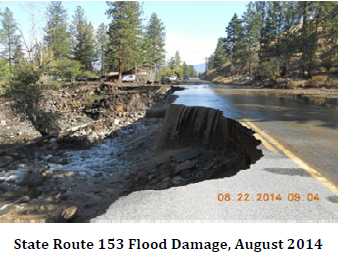 |
FHWA found SR 20's emergency and permanent repairs eligible for 100% participation under the Federal Lands Access Program (FLAP); WSDOT's matching share was reduced accordingly. SR 153's emergency repairs were eligible for 100% participation, and the SR 153 permanent repairs were eligible for the normal pro rata share of 86.5%. The initial ER contract expired before all necessary work could be completed; WSDOT advertised a second contract to complete all originally identified ER work. FHWA assisted with a simplified acquisition process, and an expedited approval to award. In addition, FHWA approved repair work on an Okanagan County road being used as a detour for SR 153. Overall, the open, candid communication that occurred between WSDOT and FHWA maximized the flexibilities within the ER program in order to get both state routes back in full operation before winter prevented completion of the work. | |
The Small Works Roster is a statewide listing of pre-qualified contractors that WSDOT uses for small (< $300K) contracts. When a project opportunity arises, all pre-qualified contractors are notified, and only those interested in providing a bid are forwarded the plans and specifications. It is simpler than normal contracting process in two ways: 1) the contract process is led by the Regions rather than by WSDOT HQ; and 2) the normal advertising requirement for the Daily Journal of Commerce (usually $2,000 – $3,000) is eliminated because the roster provides the necessary outreach.
Responding to more requests to use the Small Works Roster for Federal- aid projects, FHWA Washington Division staff met with WSDOT staff in May 2014. As a result of this meeting, the Small Works Roster process was reviewed and found to meet the federal requirements for open and unrestricted competition.
In October 2014, FHWA Washington Division staff provided formal conditional approval to extend the use of the Small Works Roster process for Federal-aid projects through FY 2015. One of the key benefits of the conditional approval is to reduce the allowable minimum advertising period from 3 weeks to 1 week as appropriate. FHWA was able to minimize the reporting requirements and allow blanket use of the Small Works Roster process rather than requiring approval on a case-by-case basis. Discussions will continue in FY 2015 to consider desired modifications to the federal requirements for these small (< $300,000) contracts.
This chart shows the timeliness of FHWA Washington Division approval for emergency relief (ER) damage inspection reports. Our goal is to approve 90% of these reports within 10 days of receipt. ER reports that exceed 16 days typically are delayed due to external permits and other factors.
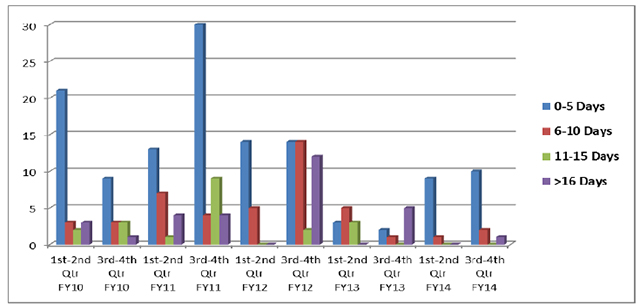
This chart shows the timeliness of FHWA Washington Division approval of documented categorical exclusions (DCEs) sem-annually from FY2010-FY2014. As the chart depicts, FHWA Washington Division continues to approve the vast majority of DCEs within the first 10 days of receipt.
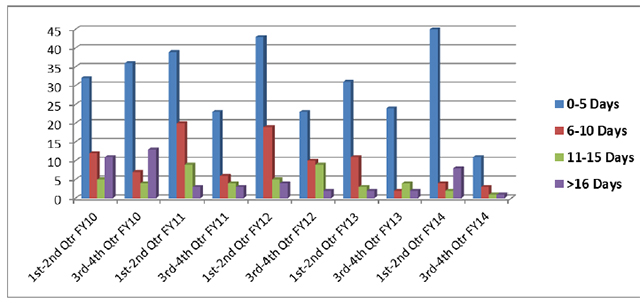
| Authorized within... | 2010 | 2011 | 2012 | 2013 | 2014 |
|---|---|---|---|---|---|
| 0 to 5 Days | 1936 | 1791 | 1655 | 2029 | 1879 |
| 6 to 10 Days | 131 | 41 | 35 | 122 | 123 |
| 11 to 15 Days | 18 | 7 | 1 | 7 | 9 |
| 16 to 20 Days | 3 | 2 | 0 | 0 | 0 |
| 20 + Days | 1 | 0 | 0 | 0 | 0 |
| Totals | 2089 | 1841 | 1691 | 2258 | 2011 |
The table above reflects the number of FHWA Washington Division authorizations / modifications approved within certain timeframes since FY2010. For FY 2013, our overall approval within a two-week turnaround was 100%, exceeding our goal of 90%! Five-day FMIS approval turnaround for FY2014 is over 93%! (FY 2015 is in progress). (Note: The Federal Fiscal Year is October 1 through September 30, 2015 is in progress.)

FHWA's quarterly target is to have under 2% inactivity on obligated federal funds. FHWA Washington Division continues to work well under that goal! The quarterly inactive percentage is found by dividing all projects inactive (no expenditures processed) for 12 months or more by each state's annual apportionments.
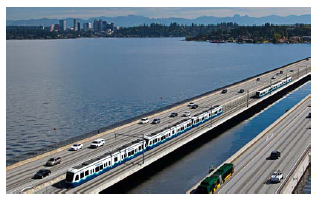 |
In June 2014, the FHWA Washington Division executed its 9th Grant Agreement for the TIGER Program in Washington State. FY 2013 Transportation Investment Generating Economic Recovery (TIGER) Grant Agreement No. 17, I-90 Two-Way Transit and HOV Project (Stage 3), received $14 million in TIGER funds. Sound Transit, the grantee, will work with WSDOT and FHWA to complete this project. The TIGER funds will be used to add 8 miles of high occupancy vehicle (HOV) lanes along the I-90 floating bridge and enhance fire suppression systems in tunnels along this important Seattle-Bellevue corridor.
|
| The project provides dedicated HOV lanes to supplement two existing reversible center HOV lanes, providing improved service times for HOV and transit users. In the longer term, this project prepares I-90 for future light rail service to be installed in the center lanes. The project will also replace the fire / life / safety systems located in the Mt. Baker tunnels connecting to the I-90 floating bridge and will make a number of seismic retrofits that will improve the earthquake resistance of the floating bridge. The contract went to advertisement August 4, was awarded November 13 after FHWA concurrence, and is scheduled to complete construction by May 31, 2017. This is a project of Division interest (PoDI) and will have enhanced oversight and FHWA approvals throughout. |
|
The latest issue of Public Roads features an article by Jeff Horton, FHWA Washington Division Area Engineer, on the events surrounding the Skagit River Bridge collapse in northwestern Washington (May 2013). The article highlights the coordinated response among numerous agencies, including WSDOT, FHWA, Skagit County Department of Emergency Management, Washington State Patrol, the U.S. Coast Guard, Naval Air Station, cities of Burlington and Mount Vernon, and others. Horton takes readers through the weeks that followed the bridge collapse, including a discussion of the detours, the temporary bridge, and the design-build approach that led to the quick replacement of the permanent bridge. Finally, Horton shares the innovations that the team used to successfully collaborate and cooperate among agencies to handle the emergency and the restoration of the bridge. See the article here. An informative video highlighting the Skagit River Bridge collapse and rebuild is also available here. |
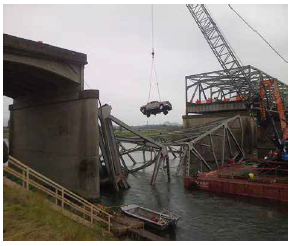 |
An update to a 1988 Memorandum of Understanding (MOU) among the EPA Region 10, WSDOT, and the FHWA Washington Division was signed in September 2014. This updated MOU clarifies the process for the EPA's review of Federal-aid highway projects that occur in the geographic area and recharge area of a designated sole source aquifer (SSA). The review involves emailing a checklist to EPA for those projects with potential to contaminate a SSA. The MOU provides further detail on the information EPA needs to provide an expedited review. The MOU also expands the list of types of projects that do not have the potential to contaminate a SSA and therefore do not require EPA review. Finally, the MOU includes additional information about the suite of regulations and policies that govern WSDOT and FHWA's protection of water quality.
| For more information contact: | ||
|---|---|---|
| Dan Mathis Division Administrator FHWA Washington Division 360-753-9480 Daniel.Mathis@dot.gov |
Sharleen Bakeman Transportation Specialist - Planning FHWA Washington Division 360-753-9418 Sharleen.Bakeman@dot.gov |
 |